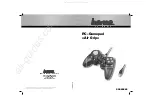
Delta Class SLA6900 UHP & SLA6800 Series Metal Sealed MFC's/MFM's
3-1
Section 3 Operation
Installation and Operation Manual
X-TMF-SLA6900-SLA6800-MFC-eng
Part Number: 541B100AAG
August, 2009
3-1 Overview
This section contains the following information:
• Theory of Operation
• Features
3-2 Theory of Operation for Flow Measurement
The thermal mass flow measurement system consists of two components:
the restrictor and the flow sensor. Figure 3-1 contains a diagram of the flow
stream through the MFC/MFM with an enlarged view of the flow sensor. Gas
flow entering the MFC/MFM is separated into two paths; one straight through
the restrictor and the other through the flow sensor. This is represented in
Figure 3-1 where the total flow A+B enters the MFC/MFM and is separated
into streams A and B. The streams are joined again at the far side of the
restrictor.
The separation of the flow streams is caused by the restrictor. During flow
conditions there will be a pressure differential across the restrictor which
forces gas to flow in the sensor.
The pressure difference caused by the restrictor varies linearly with total flow
rate. The sensor has the same linear pressure difference versus flow
relationship. The ratio of sensor flow to the flow through the restrictor remains
constant over the range of the MFC/MFM (A/B = constant). The full scale flow
rate of the MFC/MFM is established by selecting a restrictor with the correct
pressure differential for the desired flow.
The flow sensor is a very narrow, thin-walled stainless steel tube. Onto this
tube are built upstream and downstream temperature sensing elements on
either side of a heating element. Constant power is applied to the heater
element, which is located at the midpoint of the sensor tube. During no-flow
conditions, the amount of heat reaching each temperature sensor is equal, so
temperatures T1 and T2 (Fig. 3-1) are equal. Gas flowing through the tube
carries heat away from the upstream temperature sensor and toward the
downstream sensor. The temperature difference, T2 - T1, is directly
proportional to the gas mass flow. The equation is:
DT = A x P x Cp x m
Where,
DT = Temperature difference T2 - T1 (°K)
A = Constant of proportionality (S
2
-°K
2
/kJ
2
)
P = Heater Power
Cp = specific heat of the gas at constant pressure (kJ/kg - °K)
m = Mass Flow (kg/s)
A bridge circuit and a differential amplifier interpret the temperature difference
and generate an electrical signal directly proportional to the gas mass flow
rate.
Artisan Technology Group - Quality Instrumentation ... Guaranteed | (888) 88-SOURCE | www.artisantg.com
















































